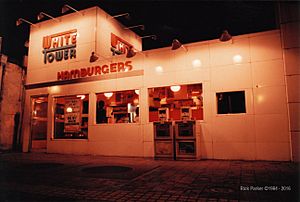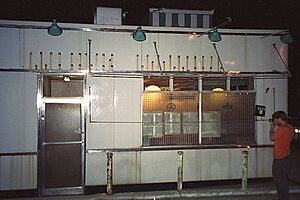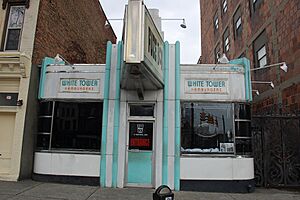White Tower Hamburgers facts for kids

White Tower restaurant in Norfolk, Virginia in 1984.
|
|
| Restaurant | |
| Industry | Fast Food Restaurant |
| Genre | Fast Food Restaurant |
| Fate | Defunct |
| Founded | 1926 in Milwaukee, Wisconsin |
| Founder | John E. Saxe Thomas E. Saxe |
| Defunct | 2004 |
|
Number of locations
|
230 peak (1950s); 1 (2021) |
| Products | Hamburgers Soft drinks |
White Tower Hamburgers was a popular fast food chain that started in 1926 in Milwaukee, Wisconsin. It was known for its white, castle-like buildings and simple menu. Many people thought it looked a lot like another chain called White Castle, which began a few years earlier.
White Tower grew quickly and opened restaurants in many big cities. These included places like Chicago, Detroit, Philadelphia, and New York City. During the Great Depression, a time when money was scarce, White Tower sold its hamburgers for just five cents! The restaurants were kept very clean. They even had staff dressed like nurses, called "Towerettes," to show how clean and safe the food was.
At its busiest in the 1950s, there were 230 White Tower restaurants. Over time, the number of locations slowly went down. Today, only one White Tower restaurant is still open in Toledo, Ohio.
Contents
History of White Tower Hamburgers
The White Tower Hamburgers chain was started by John E. Saxe and Thomas E. Saxe. They learned how to run a fast food place by studying other successful restaurants. Their very first White Tower opened near Marquette University in Milwaukee, Wisconsin. By the end of 1927, they had six restaurants in Wisconsin. By 1929, White Tower had opened 30 locations in Detroit alone! Even during the tough years of the Great Depression, White Tower kept growing and reached 130 locations. Many of their restaurants were placed near train and trolley stops, making them easy for people to visit.
Legal Battle with White Castle
In 1929, White Castle sued White Tower. White Castle claimed that White Tower had copied its building designs, slogans, and even its name. White Tower then sued White Castle back.
The court case in Minnesota ended in 1930. The judge decided that White Tower had to stop using designs and slogans that were too similar to White Castle. They also had to pay a large amount of money. Another case in Michigan lasted until 1934. It showed that White Tower had even hired a White Castle manager and taken photos of White Castle's newest buildings to copy their style.
The court decided that White Tower had deliberately copied White Castle. White Castle did not force White Tower to change its name. However, new White Tower locations had to pay a fee and send photos of their buildings. Because of this, White Tower started using different building styles, like art deco and modern designs. From then on, White Tower and White Castle mostly avoided opening restaurants in the same areas.
Growth and Later Changes


In 1941, the main office for White Tower moved to Stamford, Connecticut. By the mid-1950s, White Tower was at its biggest, with 230 restaurants across several states. They even tried out a new idea called "Tower-O-Matic," which was an automated restaurant, but it didn't work out well. They also tried a sit-down restaurant called Marbett's. Many White Tower restaurants built later in the suburbs offered "curb service," where car hops would bring food right to your car.
In 1970, Brock Saxe took over as president of the company from his father, T. E. Saxe. Brock changed the company's name to Tombrock Corporation on its 50th birthday. This was because the company also owned other restaurants. By 1979, many people had moved to the suburbs, and most White Tower locations were still in cities. Only 80 Tombrock Corporation-owned locations remained. Tombrock Corporation then started to own franchises of other popular fast food chains like Burger King and Golden Skillet Chicken.
Today, Tombrock Corporation no longer runs restaurants. Instead, it focuses on real estate, buying and managing properties. The White Tower trademark, which protects its name and logo, expired in 2005.
Images for kids






